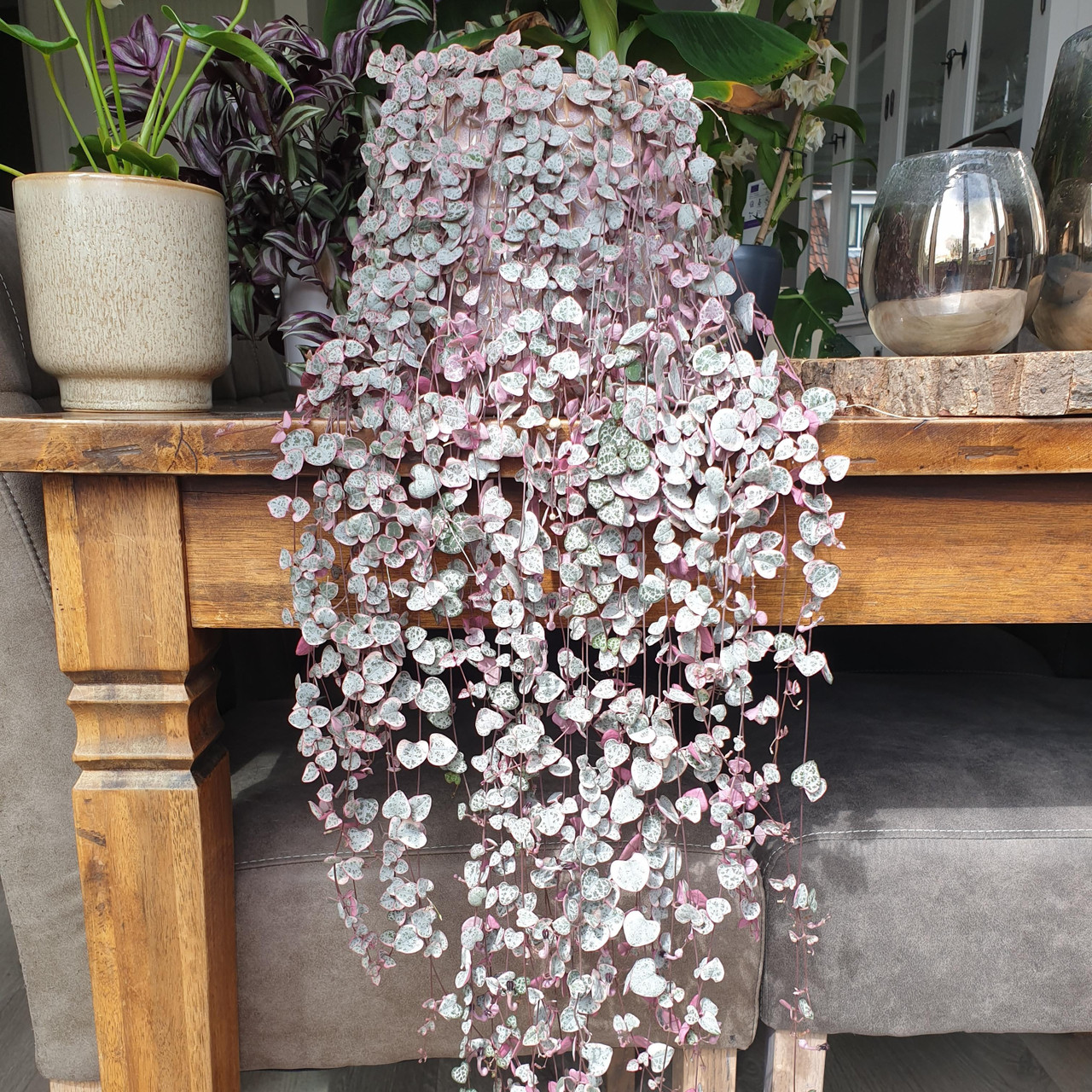Variegated String of Hearts is a visually striking trailing houseplant. Its heart-shaped leaves display a unique pattern of variegation.
The Ceropegia woodii variegata, commonly known as the Variegated String of Hearts, captivates with its cascading tendrils and delicate, marbled foliage. Native to South Africa, this succulent is both easy to care for and an enchanting addition to any indoor garden collection.
As a drought-tolerant plant, it thrives with minimal watering, making it perfect for those new to gardening or with busy lifestyles. Its vining nature allows it to gracefully drape over shelves or hang from baskets, adding a touch of greenery to any room. Enthusiasts prize the Variegated String of Hearts for its unique appearance and low-maintenance care requirements, making it an ideal choice for plant lovers of all levels.

A Delightful Addition To Your Indoor Space
The Variegated String of Hearts, scientifically known as Ceropegia woodii variegata, is a captivating trailing plant, distinguished by its heart-shaped leaves with striking patterns in shades of green, white and pink. This plant is a variety without the uniform green color, displaying a mosaic of colors that seem to dance on each leaf.
Gardeners and plant enthusiasts find the Variegated String of Hearts especially appealing due to its unique variegation and ease of care. Its vines cascade elegantly, making it an ideal choice for hanging baskets or elevated planters, enhancing any indoor environment with a touch of nature’s splendor. The plant is not only aesthetically pleasing but is also known to purify the air, making it a healthful addition to your home.
Growing And Caring For Variegated String Of Hearts
The Variegated String of Hearts thrives in conditions that mirror its native environment. Well-draining soil is fundamental to prevent overwatering, ensuring the delicate roots do not become waterlogged. Employ a mix that incorporates perlite or sand for increased drainage. It’s essential to find the sweet spot of watering where the soil is allowed to dry out partially between watering sessions, as succulent plants, like this one, are susceptible to root rot. Maintaining moderate humidity levels will mimic the perfect balance found in its natural habitat.
When discussing light and temperature, it is crucial to recognize that the Variegated String of Hearts is a lover of bright, indirect sunlight. Direct sunlight might be too harsh and can scorch the leaves, while too little light can cause the plant to lose its variegation. Aim for a cozy temperature range between 18°C and 24°C (64°F and 75°F) to encourage vibrant growth. This temperature range helps in avoiding cold drafts or excessive heat that could potentially damage the plant.
Propagation And Maintenance
Variegated String of Hearts, or Ceropegia woodii variegata, thrives through several propagation methods. Cuttings, water propagation, and soil propagation stand out as popular techniques. Ensure to use a sterilized pair of shears and select a healthy segment for the best results. Cuttings should showcase a mix of leaf and stem nodes. For water propagation, immerse the nodes in water, changing it weekly until roots develop. Soil propagation involves planting the cutting directly into a well-draining soil mix, maintaining consistent moisture levels without waterlogging.
Common pests and diseases include mealybugs, spider mites, and fungal problems. Regular inspection and prompt treatment with neem oil or insecticidal soap help prevent infestations. Proper air circulation and avoiding overwatering are crucial in preventing fungal diseases.
To ensure a healthy Variegated String of Hearts, follow these maintenance tips: provide bright, indirect light, allow the soil to dry out between waterings, and fertilize sparingly during the growing season. Pruning encourages fuller growth and removes any yellow or dead leaves, promoting vigorous health and aesthetics.

Credit: mountaincrestgardens.com
Conclusion
Caring for a Variegated String of Hearts plant adds a vibrant touch to any indoor garden. With its mesmerizing foliage and easy-going nature, this plant is perfect for enthusiasts and novices alike. Embrace its charming trails and enjoy the lush, heart-shaped leaves that bring life and color to your space.
Happy gardening!
Frequently Asked Questions Of Variegated String Of Hearts
Is Variegated String Of Hearts Rare?
The Variegated String of Hearts is somewhat rare and sought-after by plant enthusiasts for its unique, patterned foliage. It’s less common than the non-variegated type, making it a prized specimen for collectors.
How Do You Take Care Of A Variegated String Of Hearts?
Place your Variegated String of Hearts in bright, indirect light. Water sparingly, allowing the soil to dry between watering. Choose well-draining cactus mix soil. Keep it in a room with temperatures between 18-24°C. Fertilize monthly during growing seasons. Avoid cold drafts and direct sunlight.
Why Are String Of Hearts So Expensive?
String of hearts are often expensive due to their slow growth rate, popularity among plant enthusiasts, and limited availability. Their intricate variegation and vining nature also contribute to their higher price.
Why Is My Variegated String Of Hearts Turning Green?
Your Variegated String of Hearts may turn green due to insufficient light. Variegated plants need more light to maintain their colorful patterns, so place them in bright, indirect sunlight to encourage variegation.
